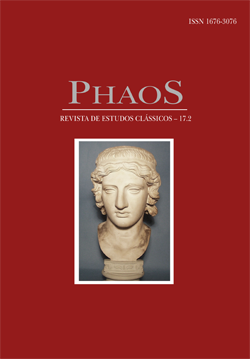O epigrama fúnebre e a embriaguez
Palabras clave:
Epigrama fúnebre, Livro VII da Antologia Palatina, embriaguez, vinho, morte.Resumen
O artigo visa a analisar uma das formas que alguns epigramatistas usam para incorporar a embriaguez na composição de alguns epigramas fúnebres do livro VII da Antologia Palatina (398 de Antípatro de Tessalônica; 533 de Dioníso de Andros e 660 de Teócrito): mortes em decorrência de quedas pós-bebedeira.Citas
ARGENTIERI, L. (2003). Gli epigrammi degli Antipatri. Bari: Levante Editori.
BECKBY, H. (1957–8). Anthologia Graeca. 4 vols. Münich: Ernst Heimeran Verlag.
CAIRNS, F. (2016). Hellenistic Epigram: Context of Exploration. Cambridge: University Cambridge Press.
FANTUZZI, M.; HUNTER, R. (2004). Tradition and Innovation in Hellenistic Poetry. Cambridge: University Cambridge Press.
GIANGRANDE, G. (1968). Sympotic Literature and Epigram. In: DIHLE, A. (ed.) L’Épigramme Grecque. Vandoeuvres-Geneva, pp. 93–174.
GOW, A. S. F.; PAGE, D. L. (1965). The Greek Anthology: Hellenistic Epigrams. 2 vols. Cambridge: Cambridge University Press.
GOW, A. S. F.; PAGE, D. L. (1968). The Greek Anthology: The Garland of Philip. 2 vols. Cambridge: Cambridge University Press.
HUNTER, R. (1992). Callimachus and Heraclitus. Materiali E Discussioni per L'analisi Dei Testi Classici, n. (28), pp. 113-123.
KACZCO, S. (2009). From Stone to Parchment: Epigraphic and Literary Transmission of Some Greek Epigrams. Trends in Classics, n.1(1), pp. 90-117.
KACZCO, S. (2016). Archaic and Classical Attic Dedicatory Epigrams. An Epigraphic, Literary, and Linguistic Commentary. Berlin, Boston: De Gruyter.
LOUDEN, B. (1999). The Odyssey: structure, narration and meaning. Baltimore: Johns Hopkins University Press.
MACQUEEN, J. (1982). Death and Immortality: A Study of the Heraclitus Epigram of Callimachus. Ramus, n.11(1), pp. 48-56.
PAGE, D. L. (1981). Further Greek Epigrams. Cambridge: Cambridge University Press.
PAGE, D. L. (1978). The Epigrams of Rufinus. Cambridge: Cambridge University Press.
PATON, W. R. (1916–9). The Greek Anthology. 5 vols. Cambridge, London: Harvard University Press.
REITZENSTEIN, R. (1893). Epigramm und Skolion: Ein Beitrag zur Geschichte der alexandrinischen Dichtung. Giessen: Hildesheim.
ROSSI, L. (2001). The Epigrams Ascribed to Theocritus: A Method of Approach. Hellenistica Groningana V. Leuven: Peeters.
SENS, A. (2016). Party or Perish: Death, Wine, and Closure in Hellenistic Sympotic Epigram. In: CAZZATO, V.; OBBINK, D.; PRODI, E. The Cup of Song: Studies on Poetry and the Symposium. Oxford: Oxford University Press, pp. 230-246.
WALSH, G. B. (1991). Callimachean Passages: The Rhetoric of Epitaph in Epigram. Arethusa, n. 24, pp. 77–103.
WERNER, C. (2014). Odisseia: Homero. São Paulo: Cosac Naify.
Descargas
Publicado
Número
Sección
Licencia
Ao se submeterem textos para a PhaoS, seus autores devem estar cientes de que, se aprovados para publicação, a revista terá sobre eles todos os direitos autorais pertinentes. Originais não serão devolvidos.

